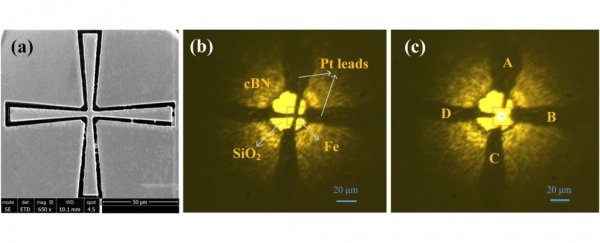At some point in Earth's 4.5-billion-year history, its entirely liquid iron core cooled enough to form a solid ball in the centre. Today, our planet's core consists of a solid iron inner core surrounded by a molten iron outer core, but pinning down exactly when this change occurred has proven quite difficult.
Estimates range from 4.5 billion years ago - the age of Earth itself - to 565 million years ago; now, a new study has finally narrowed it down. According to data obtained in laboratory experiments that create conditions approaching those in the planetary core, the age of the inner core should be somewhere between 1 billion and 1.3 billion years.
In turn, this helps us to narrow down the age of the geodynamo, which powers the magnetic field around Earth. This magnetic field contributes to conditions hospitable to life as we know it by protecting the planet's atmosphere from being blown away by the solar wind.
Therefore, it will come as no surprise that scientists are deeply interested in how it came to exist, and how it is maintained.
"People are really curious and excited about knowing about the origin of the geodynamo, the strength of the magnetic field, because they all contribute to a planet's habitability," said geoscientist Jung-Fu Lin of The University of Texas at Austin.
The geodynamo is created by the circulation of conducting iron in the outer core, driven by convection that's powered by two mechanisms.
Firstly, there's thermal convection, generated by temperature fluctuations; this can occur in a fully liquid core. Secondly, there's compositional convection, in which lighter elements released at the inner core boundary rise through the liquid outer core, creating movement.
In both cases, this conducting liquid creates electric currents which charge the core, essentially turning it into a giant electromagnet. Et voila! A magnetic field. Currently, both types of convection are present in Earth's core, equally contributing to the geodynamo.
But before the solid core crystallised, only thermal convection was possible in Earth's core. This is capable of generating the geodynamo, but in order to maintain it over billions of years, as is required for the younger estimates of the inner core's age, the iron would have needed to be extremely hot - unrealistically so.
To conduct and maintain such temperatures, the thermal conductivity of iron - as in, the ability to conduct heat efficiently - needs to be high. So, the team decided to look into the thermal conductivity of iron under pressures and at temperatures approaching those in the core.
To do this, they took an iron sample, blasted it with lasers to heat it up, and squished it in a diamond anvil. It took much longer to do than it does to describe: many attempts over two years. Finally, however, the team managed to measure the electrical and thermal conductivity of the sample under 170 gigapascals of pressure (that's 1.7 million times the atmospheric pressure at sea level), and temperatures of 3,000 Kelvin.
The pressures in the outer core range from 135 to 330 gigapascals from the outer boundary to the boundary of the inner core, while temperatures range from 4,000 to 5,000 Kelvin. The inner core is thought to reach above 6,000 Kelvin (but the iron solidifies under the intense pressure).
When the team measured the conductivity in the sample, they found it 30 to 50 percent lower than what would be required for the 565-million-year age estimate for the inner core. Hence, the researchers could place an upper limit on the thermal conductivity of liquid iron under core conditions - which, in turn, places an upper limit on how much heat could be conducted and retained.
With all this, they could finally estimate the age of Earth's inner core.
"Once you actually know how much of that heat flux from the outer core to the lower mantle, you can actually think about when did the Earth cool sufficiently to the point that the inner core starts to crystallise," Lin said.
The team's timeline, interestingly, falls neatly with a change in Earth's magnetic field. The arrangement of magnetic materials in rocks dating back 1 to 1.5 billion years ago shows that there was an increase in magnetic field strength at around this time - as would be expected for the time at which the inner core crystallised.
However, a similar increase was also seen at 565 million years ago. If the inner core crystallised earlier, that means whatever Earth did 565 million years ago is still a mystery.
"Further interrogations between mineral physics, geodynamics, and paleomagnetism are needed to resolve this discrepancy," the researchers wrote.
The research has been published in Physical Review Letters.
